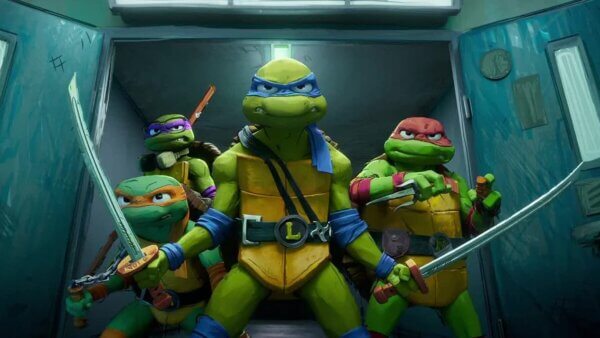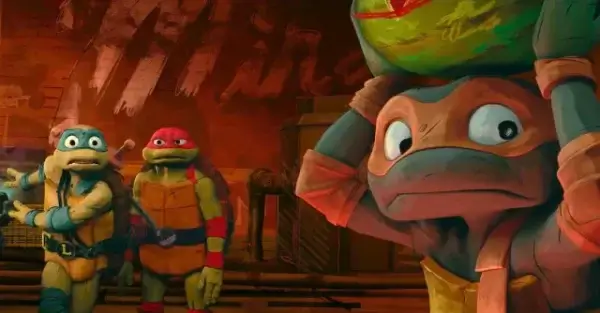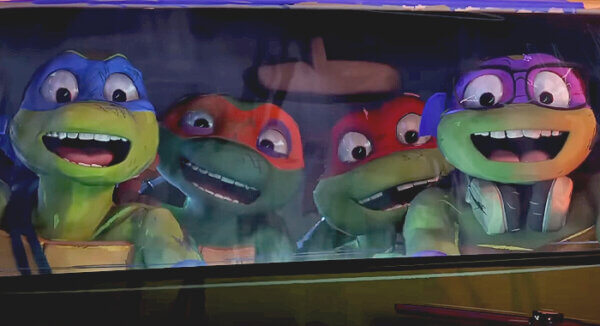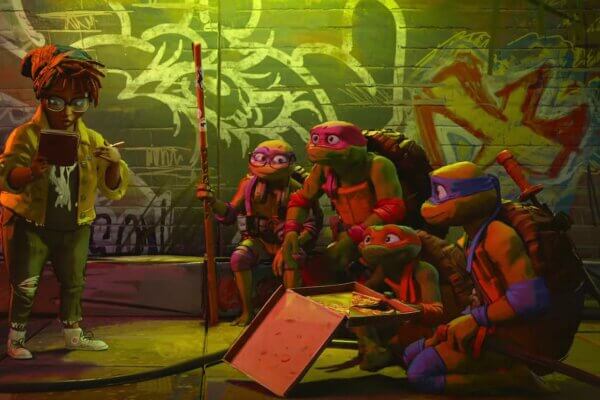Designing Teenage Mutant Ninja Turtles: Mutant Mayhem with Jeff Rowe and Ramsay McBean
Teenage Mutant Ninja Turtles: Mutant Mayhem is being released under Paramount Pictures, the writers and actors under which are currently on strike due to unfair working conditions, compensation and a refusal on the part of the studios to properly regulate AI. The Writers Guild are not calling for a boycott on coverage of their work. Skwigly stands with the WGA and SAG-AFTRA.
Annecy 2023 saw a work-in-progress screening of Teenage Mutant Ninja Turtles: Mutant Mayhem met with a standing ovation. The footage, a mix between completed animation and unrendered CG, promised a charming journey with the ninja turtles while showcasing the painterly, off-kilter art style that was met with an outpouring of praise upon the release of the film’s trailer.
Mutant Mayhem is yet another example of mainstream animation moving away from hyper-realistic, ultra-clean showcases of the power of CGI, towards an art form that celebrates the medium’s origins. Hand drawn scribbles and brush strokes encompass clay-like CG models. Expectations of what a background, a building, a face can look like are thrown out the window with this wonderfully misshapen art style.
“I was the biggest fan of Nickelodeon and the things like Rugrats and CatDog and Angry Beavers,” director Jeff Rowe told Skwigly. “So many of those shows look crazy. They look so weird. Tommy Pickles, I think some people could argue, is an ugly character design. I think it’s beautiful. I think it’s an amazing character design. But there’s something about playing with that vocabulary and letting things be bold and letting things be weird that really served the story and these imperfect impoverished characters.” Mutant Mayhem is a continuation of Nickelodeon history while being a representation of the metamorphosis of teenage years.
One of the film’s producers, Ramsay McBean, worked on the side of animation vendor Mikros, who Nickelodeon hired to help on the film. McBean carried with him a passion for artistry which matched that of Rowe, their goal of having a unique-looking film aligning. “I know that the team that Mikros, we all had the attitude of like, ‘you give us a painting, we’re going to make your painting move,’ like, we’re not going to try and like make it look like the CG version of your painting, we’re going to make your painting.”
That ability to stay true to the intent of the original artist allowed for a harmonious production between Ramsay’s team at Mikros and the team assembled by Rowe, which included alumni from his co-directing effort, The Mitchells vs. The Machines. Rowe spoke about becoming more confident after his experience on Mitchells, “I think on Mitchells, we were a little bit timid because we [Rowe and Mike Rianda] were first time directors. We were like, ‘Are we sure we wanna put a line around these characters?’ going into this film, I was like, ‘there will be lines on the characters, there’ll be lines around the characters, I’m not going to ask permission.’”
The desire to separate themselves from the animation norm was a priority for all members of the team. Achieving this in the art style is one thing, but McBean and Rowe wanted to redefine the way in which a big, mainstream animated story could be told. “The opening of the movie kind of sets the audience into a place of like, ‘oh, this is not the movie I thought I was going to see.’ And it’s always fun to watch an audience transition from the opening, to meeting the turtles, to then realising the balance of the film, because we’re really trying to push the storytelling and the cinematic language used in animation.”
That opening of the film features five minutes of action, without the jokes and dynamics one would expect from seeing the trailer. Rowe bet on audiences being engaged with the conflict of the story first and foremost, rather than throwing the turtles front and centre from the start.
When comedic elements are introduced, even they fall outside of the standards of mainstream animation. “When you make animated studio films, they always tell you that you gotta have a lot of physical comedy because that’s what makes movies popular internationally,” explains Rowe. “We tried to lean away from that, we tried to get comedy out of characters and their interactions and just the things that they say.”
Being unique is to be celebrated, but the filmmakers also owed it to the movie to do justice for the Teenage Mutant Ninja Turtles. This was achieved by actually making them teenagers. Comedy is derived from their turns of phrases, their constant talking over each other and general silliness. The move from physical comedy to finding comedy in dialogue was a genius choice for this cast of characters.
Another thing the film had to deliver on was action, but Rowe was keen to keep the fight scenes grounded in the identities of the turtles. “The moment these teen characters that we’ve put so much work into being relatable to the audience start flipping up buildings and doing things that break the laws of physics, that’s the moment I disengage as an audience member.” The film lets loose on action with side characters like Superfly and, of course, Master Splinter. Being voiced by Jackie Chan, Splinter’s fighting style reflects that of Chan’s most famous work, taking advantage of the environment for more creative choreography.
90s hip-hop plays a big role in the feel and atmosphere of Mutant Mayhem, bringing dusty boom-bap to this wonky, grimy world of mutants brings the piece together. The use of A Tribe Called Quest’s “Can I Kick It?” in the marketing of the film is a great indicator for what the tone of the film is while paying homage to the era in which the Turtles came to prominence.
“It’s definitely a contemporary film, we needed it to be a contemporary film, but so much of my nostalgia with the Ninja Turtles is wrapped up in the 80s and 90s,” says Rowe. “That generation of music, Spike Lee films, being a kid and going to the Burger King Kids Club, the way that things looked and felt and it was like a nice way to evoke that era without the film explicitly having to take place there.”
Mutant Mayhem represents a landmark for fans of the Ninja Turtles franchise. Their adaptations to the big screen have repeatedly missed the mark, swaying from what makes these characters loveable. But the screen being bigger doesn’t mean the turtles have to change, and Mutant Mayhem looks to finally do them justice.
Teenage Mutant Ninja Turtles: Mutant Mayhem is out UK cinemas now






